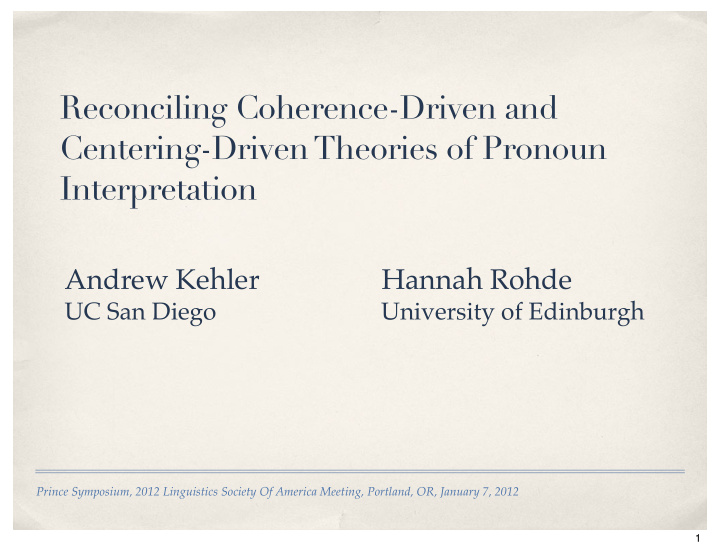



Reconciling Coherence-Driven and Centering-Driven Theories of Pronoun Interpretation Andrew Kehler Hannah Rohde UC San Diego University of Edinburgh Prince Symposium, 2012 Linguistics Society Of America Meeting, Portland, OR, January 7, 2012 1
T wo Approaches to Discourse Coherence ✤ Centering Theory (Grosz et al. 1986; 1995): “Certain entities in an utterance are more central than others and this property imposes constraints on a speaker’s use of different types of referring expressions” ... “the use of a pronoun to realize the C b signals the hearer that the speaker is continuing to talk about the same thing.” Mitt narrowly defeated Rick, and campaign donors began flocking to him. [ him = Mitt ] Rick was narrowly defeated by Mitt, and campaign donors immediately began to flock to him. [ him = Rick ] ✤ Semantics and world knowledge do not come into play 2
Coherence and Coreference Hobbs’ (1979) Coherence-Driven Approach ✤ ✤ Pronoun interpretation occurs as a by-product of general, semantically-driven reasoning processes ✤ Pronouns are modeled as free variables which get bound during inferencing (e.g., coherence establishment) Mitt narrowly defeated Rick, and he asked that the vote be certified. Mitt narrowly defeated Rick, and he asked that the vote be recounted. ✤ Choice of linguistic form does not come into play 3
Biases Vary by Coherence Relation ✤ Stevenson et al. (1994) found a Source Referent Goal Referent 50-50 pronoun bias in sentence completions with Source-Goal 200 transfer-of-possession contexts: 160 Bush passed the speech to Cheney. 120 He _______________________ 80 ✤ Rohde et al (2006) asked 40 whether the bias varied by the type coherence relation between 0 Occasion Elaboration Explanation the clauses (195) (142) (82) 4
Results Source Referent Goal Referent ✤ Rohde et al. ran the previous experiment again, except with 100 different instructions for how to 80 continue the passage: 60 ✤ What happened next? (Occasion) 40 ✤ Why? (Explanation) 20 ✤ Stimuli kept identical across 0 conditions What happened next? Why? 5
The Subject Preference ✤ Stevenson et al’s (1994) study paired their pronoun-prompt condition with a no-prompt condition: Bush passed the speech to Cheney. He ____________ Bush passed the speech to Cheney. _______________ ✤ They found a near 50/50 split in Source vs. Goal interpretations for pronouns in the prompt condition ✤ But in the no-prompt condition, they found a strong tendency to use a pronoun to refer to the subject and a name to refer to the object (replicated by Arnold, 2001 and Rohde and Kehler 2008) 6
Bayesian Interpretation (Kehler et al. 2008) ✤ Bayesian formulation: Production Prior Expectation Prior Expectation (Centering-Driven) Production (Coherence-Driven) Interpretation P(pronoun|referent) P(referent) P(referent|pronoun) = P(pronoun) ✤ Our data are consistent with a scenario in which coherence-driven biases primary affect probability of next-mention , whereas Centering biases (subject/topic) affect choice of referential form ✤ Fukumura and van Gompel (2010) tested this latter prediction 7
Implicit Causality ✤ Previous work has shown that so-called implicit causality verbs are associated with strong pronoun biases (Garvey and Caramazza, 1974 and many others) Amanda amazes Brittany because she _________ [subject-biased] Amanda detests Brittany because she _________ [object-biased] ✤ Therefore, the subject-biased v. object-biased IC verb distinction provides a basis to test whether interpretation biases affect pronoun production 8
IC Manipulation (Fukumura and van Gompel, 2010) subj-biased obj-biased ✤ Contexts: 100 ✤ Gary scared Anna after the 80 long discussion ended in a row. This was because... 60 [subject-biased] 40 ✤ Gary feared Anna after the long discussion ended in a 20 row. This was because... [object-biased] 0 Subject Object 9
Centering and Topichood ✤ Bayesian formulation again: Production Prior Expectation (Centering-Driven) (Coherence-Driven) Interpretation P(pronoun|referent) P(referent) P(referent|pronoun) = P(pronoun) ✤ The original Centering rule says to pronominalize the topic (with subject position being a weak indicator of topichood in active voice) ✤ Therefore, a manipulation that increases the likelihood that a referent is the topic should influence pronoun production 10
IC and Passivization ✤ We used subject-biased IC verbs to test several predictions: Amanda amazed Brittany. She _________ Brittany was amazed by Amanda. She __________ Amanda amazed Brittany. _____________ Brittany was amazed by Amanda. ______________ ✤ Question 1: Does passivization change the pronoun interpretation bias? ✤ Question 2: Does passivization change the pronoun production bias? 11
Results: Mentions Active Passive ✤ Preference for causally- implicated referent 100 (p<.001) 80 ✤ Subject bias for 60 pronouns (p<.001) 40 ✤ Interaction: Reduced bias for causally- 20 implicated referent in 0 passive/pronoun Pronoun No Pronoun condition (p<.05) % References to logical subject 12
Results: Production Active Passive ✤ Greater rate of pronominalization to 100 the subject than non- subject 80 ✤ Greater rate of 60 pronominalization for 40 passive subjects than active ones 20 ✤ No difference for non- 0 Subject Non-Subject subjects, as expected % Pronouns 13
A Third Prediction Active Passive Previous work has revealed a ✤ substantial bias toward Explanation continuations 100 with prompts without because (Kehler et al., 2008) 80 A third prediction that arises ✤ 60 is that passivization, by pulling pronoun references away from the causally- 40 implicated referent, should reduce the percentage of 20 Explanations 0 The prediction was ✤ Pronoun No Pronoun confirmed: Fewest Explanations in Pronoun+ % Explanation relations Passive condition (p<.001) 14
Conclusions ✤ The data presented here suggests a potential reconciliation of coherence- relation-driven and Centering-driven theories that accords with this view: ✤ Coherence relations create top-down expectations about next mention ✤ Centering-style constraints yield bottom-up evidence specific to choice of referential form ✤ Fits within a modern view in psycholinguistics that casts interpretation as the interaction of “top-down” expectations and “bottom-up” linguistic evidence ✤ We have gained insight into why we see evidence for both syntactic and semantic ‘preferences’ and their emergence in different contextual circumstances ✤ The behavior of pronouns is thus an important source of insight into larger questions concerning the discourse processing architecture 15
Thank you! 16
Recommend
More recommend